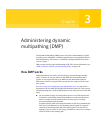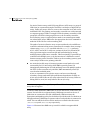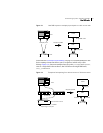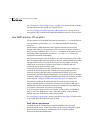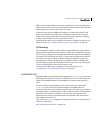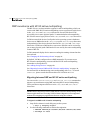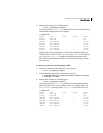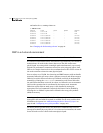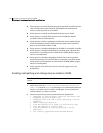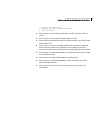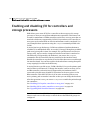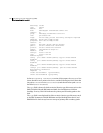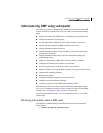
132 Administering dynamic multipathing (DMP)
How DMP works
and under the new naming scheme as:
# vxdisk list
DEVICE TYPE DISK GROUP STATUS
disk155 auto:LVM - - LVM
disk156 auto:LVM - - LVM
disk224 auto:cdsdisk - - online
disk225 auto:cdsdisk - - online
disk226 auto:cdsdisk - - online
disk227 auto:cdsdisk - - online
disk228 auto:cdsdisk - - online
disk229 auto:cdsdisk - - online
See “Changing the disk-naming scheme” on page 91.
DMP in a clustered environment
Note: You need an additional license to use the cluster feature of VxVM.
In a clustered environment where Active/Passive type disk arrays are shared by
multiple hosts, all nodes in the cluster must access the disk via the same
physical path. Accessing a disk via multiple paths simultaneously can severely
degrade I/O performance (sometimes referred to as the ping-pong effect). Path
failover on a single cluster node is also coordinated across the cluster so that all
the nodes continue to share the same physical path.
Prior to release 4.1 of VxVM, the clustering and DMP features could not handle
automatic failback in A/P arrays when a path was restored, and did not support
failback for explicit failover mode arrays. Failback could only be implemented
manually by running the
vxdctl enable command on each cluster node after
the path failure had been corrected. In release 4.1, failback is now an automatic
cluster-wide operation that is coordinated by the master node. Automatic
failback in explicit failover mode arrays is also handled by issuing the
appropriate low-level command. If required, this feature can be disabled by
selecting the “no failback” option that is defined in the array policy module
(APM) for an array.
Note: Support for automatic failback of an A/P array requires that an
appropriate ASL (and APM, if required) is available for the array, and has been
installed on the system. See “Administering the Device Discovery Layer” on
page 85 and “Configuring array policy modules” on page 162.
For Active/Active type disk arrays, any disk can be simultaneously accessed
through all available physical paths to it. In a clustered environment, the nodes
do not all need to access a disk via the same physical path.




